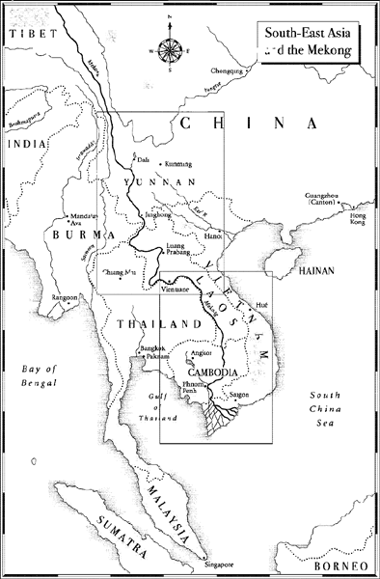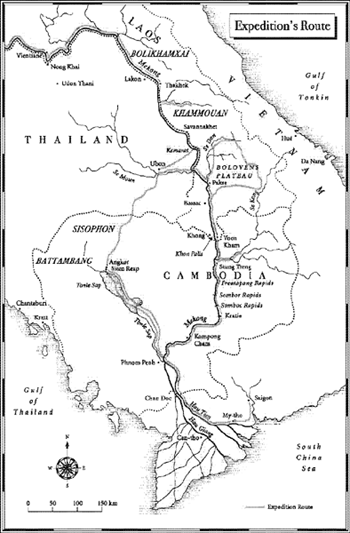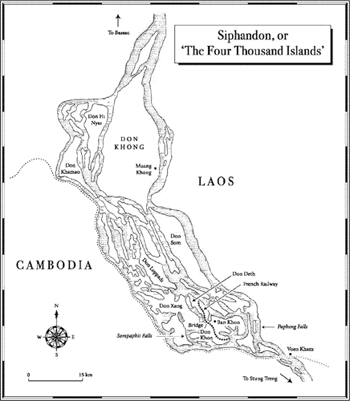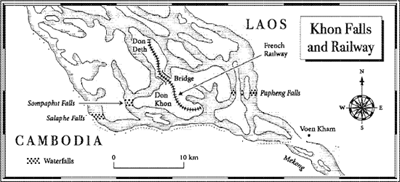
Полная версия:
Mad About the Mekong: Exploration and Empire in South East Asia

JOHN KEAY
MAD ABOUT
THE MEKONG
Exploration and Empirein South-East Asia

DEDICATION
FOR ALEXANDER
CONTENTS
Cover
Title Page
Dedication
Foreword
An Indo-China Chronology
1 Apocalypse Then
2 Shuttle to Angkor
3 To the Falls
4 Unbuttoned in Bassac
5 Separate Ways
6 River Rivals
7 Hell-Bent for China
8 Heart of Darkness
9 Into the Light
10 Death in Yunnan
Epilogue
Acknowledgements
By the Same Author
A Short Bibliography
Index
About the Author
Praise
Copyright
About the Publisher
Maps





FOREWORD
In the great age of exploration, while momentous expeditions in Africa were grabbing the English-language headlines, a French initiative through the heart of south-east Asia was arguably more ambitious than any of them. The Mekong Exploration Commission of 1866—68 outmarched David Livingstone and outmapped H.M. Stanley. It also outshone them in that display of sociological categorising, economic sleuthing and political effrontery that was expected of nineteenth-century explorers. In darkest Africa the British were feeling their way, but the French in tropical Asia unashamedly advertised their patriotic intentions, planted their flag and promoted their rule wherever they could. Empire-building was their business. An ‘empire of the Indies’, otherwise French Indo-China, would duly emerge as a direct outcome of the expedition.
The human cost of travel in the south-east Asian subcontinent was as high as in Africa, and the disappointments just as acute. Danger overtook the Mekong expedition within a week of its official departure; tragedy struck within a week of its effective conclusion. In between, as they clocked up the months and the kilometres in a marathon of survival, the explorers fought their way through the equatorial forests of Cambodia and Laos to climb from the badlands of remotest Burma onto blizzard-swept tundra along the China-Tibet border. Rarely was at least one of the six officers – and sometimes all of them – not delirious or incapacitated. Tigers barred their path, village maidens diverted their attentions, forbidden cities yielded up their secrets. The boats got smaller and the river more impetuous. They took to the jungle, riding on elephants, bullock carts and horses; mostly they just sloshed through the monsoons knee-deep in mud and festooned with leeches. If only as an epic of endurance, the story of the Mekong Exploration Commission dwarfs nearly all contemporary endeavours.
Yet – and hence this book – it is to most people unknown. Doudart de Lagrée, Francis Garnier and their companions are not household names. Any geographical features once called after them have long since been erased from the maps; and histories and anthologies of exploration habitually ignore them (my own included). One might suppose this to be an anglophone conceit. Had the Commission been British, London would now be graced with statues of the Mekong pioneers, streets would be named after them, and symposia convened for them. Their mistake, as Garnier himself wryly put it just before his premature death, lay in being born French.
Posthumous amends had, I presumed, been made in Paris, but it was during an encounter with the French ambassador in London that I first found a chance to confirm this. By way of something to say, I enquired how the Commission was commemorated in France. The ambassador looked blank. A charming and erudite diplomat, he evidently didn’t understand the question. I plied him with names, dates and places. He shook his head.
‘Never heard of them, I’m afraid.’
‘But that’s like a British ambassador saying he’s never heard of Dr Livingstone, or Scott of the Antarctic.’
‘Ah, but you don’t understand. In France we have a different attitude to the colonial past.’
A visit to Paris eventually bore this out. Except in the Bibliothèque Nationale and among the treasures poached from Angkor in the Musée Guimet, mention of the Commission brought nothing but Gallic shrugs. A friend whom I counted as an ardent supporter eventually confessed that even he only knew of the expedition because of my incessant prattling about it. Rue Garnier turned out to be named not for Francis Garnier; likewise the tomb in the Père Lachaise cemetery that is commonly awarded to him. Both pertain to some other Garnier. The short entry under ‘Garnier, Francis’ in the popular Larousse dictionary of biography contains only a sentence on the expedition; there is no entry at all for its leader, Doudart de Lagrée.
If one excludes the writings of its own personnel, scarcely any more accounts of the expedition exist in French than in English. The most recent and well researched (J.P. Gomane, 1994) appears never to have got beyond the limited circulation accorded to a typewritten thesis so scrunched into its binding as to be almost unopenable. The most ambitious and accessible reconstruction (Osborne, 1975) is by an Australian.
Celebrating dead exponents of a somewhat discredited profession seems to be an anglophonic obsession. The French ambassador, though far too diplomatic to say so, appeared to imply that while the British were today mired in nostalgia for their imperial past, the French were above such things and in healthy denial of their own colonial aberrations. Without going into the reasons for this – which may derive as much from present confidence as from past trauma – I felt encouraged. Here was a story that could usefully be retold.
The history led to the geography. Intrigued by the expedition, I became enthralled by the river. For reasons that will emerge, the Mekong is quite unlike any of the world’s other great waterways. Far from inviting navigation it emphatically challenges it with an unrivalled repertoire of spectacular water features. As if not in themselves sufficiently discouraging, the expedition found these appalling physical difficulties compounded by political uncertainties. Colonial rule would fail to remove either, and for the past half-century ideological, bureaucratic and piratical obstructions have barred the river’s course more effectively than ever.
But there has recently been a change. In the late 1990s border restrictions were eased, new rivercraft were introduced in Cambodia, and some controversial channel-clearance was begun on the Sino – and Lao – Burmese borders. For the first time in living memory retracing the route of the Mekong Exploration Commission became feasible, if not easy. A golden age in Mekong navigation looked to be dawning.
Sadly it could prove to be short-lived. Water conservation tops the agenda of all the riverine states, while hydro-electricity provides some of them with their main export-earner. In Chinese Yunnan the river is already dammed. So are many of its downstream tributaries; the chainsaw and the mechanical digger are everywhere gouging roads round unsuspected contours; and extant plans threaten to transform the entire hydrography. Natural forest, traditional livelihoods, and the occasionally alarming interplay of menace and innocence in this great green basin may all be swept away within the next few decades.
The rehabilitation of the river could prove its undoing. On the other hand, rehabilitating the story of its exploration may be instructive. Scarcely anywhere has been more traumatised by recent history than mainland south-east Asia. Retracing the expedition’s trail means revisiting the aftermath of more twentieth-century wars – international, civil, ‘secret’ and ethnic – than even the Balkans can boast. (The Vietnam war was the third but by no means the last.) It means circumventing the best natural forest because of the unexploded ordnance, tripping through smiling landscapes memorable for unparalleled savagery, and paddling up tranquil reaches still infamous for narco-insurgency. The experience takes the edge off unalloyed enjoyment and, for a Westerner, invites self-recrimination.
But stay the whip; for the Eden into which the Mekong Exploration Commission first blundered also fell far short of the idyllic. Slavery, banditry and the prevalence of almost every known tropical disease so appalled the Frenchmen that they seemed to justify colonial intervention. The explorers did not, though, berate the prevailing rulers, and mostly they thought well of the Buddhist establishment. They just diagnosed and prescribed. Blaming the acknowledged ills of one society, or one century, on the presumptions of another demeans them both.
It is simply the sequential nature of events, and in this case of intervention—its logic and its consequences – that may be instructive. As with the river at the heart of this story, natural obstructions and human interference contain merit as well as menace. Flooded forest provides the ideal spawning ground for fish; hillside erosion upriver guarantees alluvial abundance in the Delta; and the colonial cake-cutting urged by the expedition probably forestalled more cataclysmic strife than it created. Like fully-fledged trees being tumbled perilously through the rapids, events take their course, not easily deflected yet foreseeable as to season and direction by those who trouble to study the current and read the weather.
AN INDO-CHINA CHRONOLOGY
THE ADVENT OF THE FRENCH
1859 French naval force seizes Saigon. 1862 Three Mekong Delta provinces round Saigon ceded to the French. 1864 Franco – Cambodian Treaty makes truncated Cambodia a protectorate. 1865 French naval ministry champions exploration of Mekong. 1866–68 Mekong Exploration Commission. 1867 French seize remaining Delta provinces. 1869 Survivors of Mekong expedition return to France. 1870 Paris besieged in Franco – Prussian War. 1872 Dupuis takes arms shipment to Yunnan up the Red River. 1873 First French intervention in Tonkin (North Vietnam); death of Garnier.THE FRENCH ADVANCE
1883 New French offensive in Tonkin brings protectorate over the Annam emperor. 1885–86 British invasion and annexation of Upper Burma. 1886–91 Pavie contests Siamese (Thai) sovereignty in Laos. 1891–93 French attempt to navigate Falls of Khon; Stung Treng seized. 1893 Paknam Incident and French blockade of Bangkok. Franco-Siamese Treaty ends Siamese sovereignty in Laos. 1894–95 Pavie/Scott clash over Franco-British buffer (Muong Sing). 1896 Anglo – French Declaration secures neutrality of truncated Siam. British Burma’s claims to Muong Sing withdrawn. 1904 Franco – Siamese Convention adjusts Siam – Cambodia frontier, accords Laos west bank enclaves at Bassac and Luang Prabang. 1907 Franco – Siamese Treaty brings return to Cambodia of ‘lost provinces’ (including Angkor).FRENCH WITHDRAWAL AND US INTERVENTION
1930 Nguyen Ai Quoc (‘Ho Chi Minh’) founds Indo-Chinese Communist Party. 1942–45 Japanese overrun south-east Asia. 1945–54 First (French) Indo-China War. 1949–50 Triumph of Mao’s Communists in China. Some Chinese Nationalists (KMT) relocate in Shan states. 1954 Geneva Accords and defeat at Dien Bien Phu end French rule. 1962 Military (General Ne Win) seize power in Burma. 1963–73 CIA’s ‘Secret War’ in Laos. 1965–66 First US ground troops arrive in south Vietnam. 1967 ‘Second Opium War’ as Shan, KMT and Lao drugs barons clash. 1968 500,000 US troops in Vietnam. US bombing of Cambodia begins. 1973 Paris Agreements herald withdrawal of US troops from Vietnam. 1975 Saigon falls to North Vietnamese, Phnom Penh to Khmer Rouge, and Pathet Lao triumph in Laos. 1975–79 Cambodia under Khmer Rouge. 1979 Vietnamese invade Cambodia, install puppet (Heng Samrin) regime. 1988 Burma’s military rulers suppress democratic victory (Aung San Suu Kyi). 1989 Vietnamese withdraw from Cambodia. Burma’s insurgent Communist leaders come to terms with Rangoon. 1991–93 Paris Peace Accord leads to UN deployment in Cambodia and elections. 1997 Hun Sen overthrows elected Cambodian government, engineers own mandate (1998, 2003).ONE
Apocalypse Then
‘Each bend of the Mekong as added to my map seemed an important geographical discovery. Nothing could distract me from this abiding concern. It came to possess me like a monomania. I was mad about the Mekong …’
FRANCIS GARNIER
IN EARLY JUNE the Mekong in its remote middle reaches is at its lowest. At that time of year, sixteen hundred kilometres to the north-west on the uplands of eastern Tibet, the river’s headwaters may be rippling with the first snow-melt, while the same distance to the south, the monsoon may already be pummelling the paddy fields of the Delta. But at its hill-pinched waist on the Lao-Burmese border the river has scarcely begun to rise. Here, the dry season still holds its fiery breath and the odd shower is no more than a lick of the tongue on parched lips. Behind the hills desultory thunder brings no relief. Beetles and cicadas fall silent in the heat; birds seem reluctant to fly. A smoke haze hangs motionless in the treetops, clogging the nostrils with the ash from slash-and-burn. Drained of all glow, the sun sets ingloriously, tracking behind a pall of parched fog to a mid-afternoon extinction. The thermometer stays stuck at thirty-something degrees.
Only the river is refreshingly animated. Darting through fifty-metre narrows, it bellies into pools a kilometre wide and then squirms, like a sleek and well-fed snake, down a barren trough isolated from the tousled shade of its banks by humped sandbars and a wilderness of spectacular upthrusts of black bedrock. Where the rock ventures into its path, the river hisses a caution and recoils in a tangle of eddies, welling up, flicking at the sunlight and glancing aside to nose out other options before slithering prodigiously over the obstruction in a cascade of watery colours.
Midway between Thailand and Chinese Yunnan, a succession of such encounters comprises the Tang-ho rapids. They extend, with intermissions, for perhaps 150 kilometres and confront the navigator with an awesome prospect of boiling whirlpools and spuming cataracts. In June 1867 they were the final straw for the Mekong Exploration Commission. After a year of canoeing up Asia’s most capricious river, the six Frenchmen who had undertaken its exploration conceded defeat. From here on they would take to the steep banks, then to the hills and the forests, plotting the river where possible but increasingly deflected from its course by obstructive princelings and their own debilitated condition.
Their proximity to China alone kept them going. Deep in the forest gloom they would stumble on a paved trail and then a humpbacked bridge built of cut stone and once inset with ceramic tiles. Evidently the civilising light of the Celestial Empire had once penetrated these dark recesses. A mandarin’s robes and the staccato sound of spoken Chinese sent the Frenchmen into raptures. In China their credentials would be acknowledged and their credit was good. After months of floundering amid malarial jungle, terrorised by tigers, devoured by leeches, often feverish and increasingly destitute, their salvation seemed nigh. They dreamed of wearing shoes again and sleeping in sheets, of tableware and postal facilities and the privacy of stone walls and stout doors. They were not to know that forsaking the river was the prelude to catastrophe, or that the controversies, no less than the crises, were yet to come.
Sensing only that the Mekong was about to elude them, Francis Garnier, the expedition’s restless surveyor, set off alone from the Tang-ho rapids on a last day’s excursion upriver. With a compass in his hand and a cold chicken in his haversack, he picked his way past the rapids, and as the sun slanted over the trees on the hilltops, became overwhelmed by an acute sense of wonder. The great river and the boundless forest were utterly deserted. He felt like a trespasser in paradise. He shouted to reassure himself but quickly resented the sound. His shadow, marching across the sandbanks beside him, was no less intrusive: it seemed, as Garnier put it, ‘to violate the virginity of a natural world that until now had escaped the profanity of man’.
Behind an outcrop of rock he surprised a young stag drinking from the river. Though only ten paces away, it stood its ground, and when he stopped to reach instinctively for his rifle, the stag actually moved towards him. ‘It came to me like a memory of Eden,’ he would write. Both thrilled and intimidated, he had no regrets about being unarmed, yet still could not resist making a grab for its antlers. The stag bolted and Garnier cursed his own impatience. It should have been like a fairy story, he thought, or one of La Fontaine’s fables. If only, instead of grabbing at it, he had engaged it in polite conversation.
After a hard scramble through the tangled forest to circumvent a portal of rock, he rejoined the river and, now sweating profusely, went for a swim. He was barely out of his depth when two elephants broke cover. One turned back; the other, a big dark tusker, waded into the water beside him. Garnier backed into midstream and prepared to take flight by launching himself into the main current. ‘The proboscidean’ fixed an eye on him and occasionally waved its trunk in his direction. But it did not approach. It seemed content just to wallow and shower itself with river-water. Naked and defenceless, Garnier cautiously floated into the bank and, grabbing his clothes, fled across the sands and into the forest. The elephant paid no attention. Later, on glancing back, Garnier could still see the spray from the fountain of its trunk raining down in a prism of sunlight.
Lunch was taken in the shade, then it was time to turn back. In the heat of the day the silence was more absolute than ever. Garnier longed to erase his own tracks in the sand; they too seemed to sully surroundings of such heart-rending beauty. Yet that night, back in camp when he told of his adventures, a colleague’s suggestion that they revisit this huntsman’s ‘Eldorado’ with shotguns and rifles met with no objection. For repaying nature’s ‘pacific and almost friendly’ reception with bullets Garnier felt a mild pang of remorse but said nothing. Bloodlust prevailed. Evidently virgin lands meant fair game – and that included the river itself.
This long, lyrical and perhaps fanciful passage stands out in the records of the Mekong Exploration Commission because it is so untypical. Disappointment and hardship had more often been the expedition’s lot; destitution and death would as surely follow. A day in paradise, for Garnier at least, was a moment of tranquillity set amid buffeting cascades of menace and misfortune. Here Heaven met Hades round every bend in the river. ‘This solitary Mekong scene,’ he concluded, ‘one of the last that it was given to me to see, would remain deeply etched in my memory.’
The passage is immediately preceded, and partly explained, by another admission. He had succumbed, he says, to a ‘monomanie de Mékong’. It was he who had insisted on pursuing the river long after it had become an irrelevance to the expedition’s political and commercial concerns. It was he who had deflected their course from the most direct route to China into the dangerous no-man’s land of the Shan states on the Lao – Burmese border. The river for Garnier had come to eclipse all else, including the expedition’s safety. What mattered was to map its every twist, chart its every rapid, explore its every secret. He had become, he says, obsessed by it, possessed by it, mad about it.
Mountaineers commonly get obsessed by particular peaks, exaggerating their mystique and slavering over their icy profile. A river obsession is more of a rarity. It takes an especially determined explorer and a peculiarly wayward river. Joseph Conrad set his Heart of Darkness in Africa and positioned the terrible Kurtz on the upper reaches of the Congo. In the film Apocalypse Now Francis Ford Coppola, while appropriating the Conrad story and retaining Kurtz, transposed the river. Recognising a renegade American holed up in the jungles of south-east Asia as a latter-day Kurtz, he simply swapped the Congo for the Mekong. There was little to choose between them; they were rivers ‘of a kind’. Up both lurked twilight forces of good and evil, forbidding yet enticing, virgin yet corrupting. And just as for Conrad the Congo was the obvious setting for an exploration of that ‘heart of darkness’ at the core of early twentieth-century civilisation, so for Coppola the Mekong was the obvious setting for a visionary parable of damnation in the late twentieth century.



